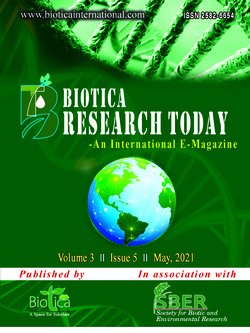
Anti-Covid Drug: 2-deoxy-D-glucose and Its Mechanism of Action
Kailash Chandra Samal
Dept. of Agricultural Biotechnology, OUAT, Surya Nagar, Bhubaneswar, Odisha (751 003), India
Bhagyalaxmi Panda
Dept. of Plant Breeding and Genetics, OUAT, Surya Nagar, Bhubaneswar, Odisha (751 003), India
Laxmipreeya Behera*
Dept. of Agricultural Biotechnology, OUAT, Surya Nagar, Bhubaneswar, Odisha (751 003), India
DOI: NIL
Keywords: 2-deoxy-D-glucose, Anti-Covid drug, DRDO, SARS-CoV-2
Abstract
2-deoxy-D-glucose (2-DG) is a glucose analogue that has been found very effective for therapeutic use as an antiviral agent against SARS-CoV-2. This glucose analogue enters into the cell like a glucose molecule. In the cytosol, it is phosphorylated to 2-deoxy-D-glucose-6-phosphate by the action of the enzyme hexokinase. The 2-deoxy-D-glucose-6-phosphate cannot be further metabolized by phosphor-glucose isomerase, which leads to the accumulation of 2-DG-P in the cell and the depletion in cellular ATP. So the cell activates the cell death pathway. The Drugs Controller General of India (DCGI) has approved for emergency use as an adjunct therapy in moderate to severe Coronavirus patients. The drug will help to save precious lives by the faster recovery of hospitalized patients and reducing oxygen dependence. It will lower down the burden on the health infrastructure of the country.
Downloads
not found
Reference
Aft RL, Zhang FW, Gius D, 2002. Evaluation of 2-deoxy-D-glucose as a chemotherapeutic agent: mechanism of cell death. Br J Cancer 87, 805-12.
Aghaee F., Islamian J.P., Baradaran B., 2012. Enhanced Radiosensitivity and Chemosensitivity of Breast Cancer Cells by 2-Deoxy-D-Glucose in Combination Therapy. Journal of Breast Cancer 15(2), 141-147.
